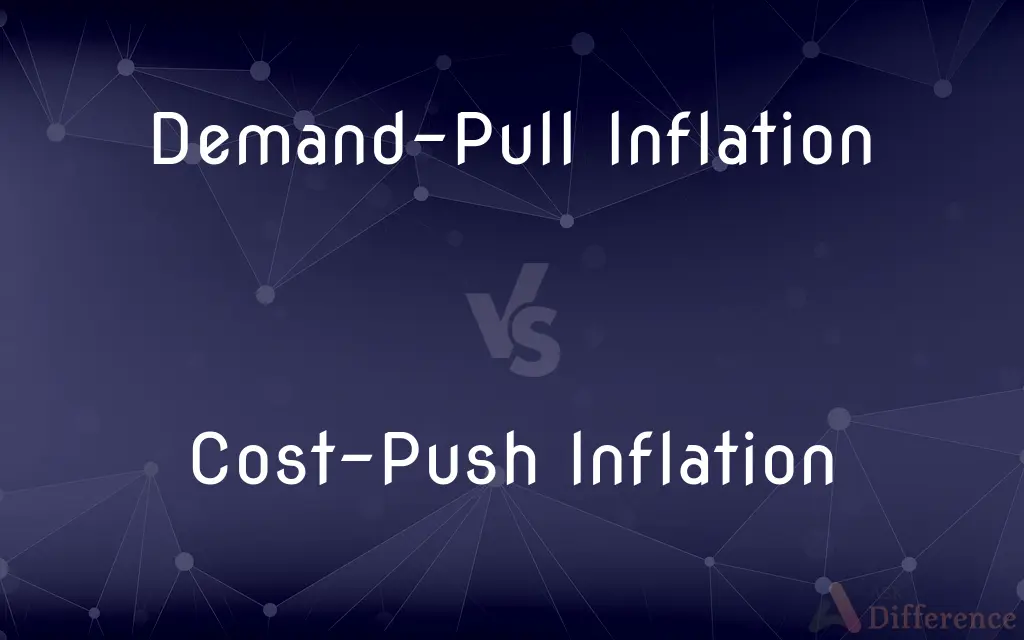Demand-Pull Inflation vs. Cost-Push Inflation — What's the Difference?
Edited by Tayyaba Rehman — By Fiza Rafique — Published on December 22, 2023
Demand-Pull Inflation arises when demand exceeds supply, while Cost-Push Inflation occurs when production costs increase, leading to higher prices for goods and services.

Difference Between Demand-Pull Inflation and Cost-Push Inflation
Table of Contents
ADVERTISEMENT
Key Differences
Demand-Pull Inflation refers to the scenario where the aggregate demand in an economy surpasses its aggregate supply, leading to a rise in the general price level. On the other hand, Cost-Push Inflation is driven by a rise in the prices of inputs like labor, raw materials, etc., which reduces the supply of the end product or service.
A surge in consumer confidence, increased disposable income, or government spending can lead to Demand-Pull Inflation. Conversely, Cost-Push Inflation can be sparked by events like oil price hikes, natural disasters impacting raw material supply, or increased wage demands by workers.
Demand-Pull Inflation typically depicts a booming economy where demand outpaces supply. In contrast, Cost-Push Inflation doesn't necessarily indicate a thriving economy but rather emphasizes rising production costs.
The remedies to curb Demand-Pull Inflation often involve reining in demand by measures like raising interest rates or reducing government spending. In the face of Cost-Push Inflation, authorities might look to control wage demands or foster competition among suppliers.
Both Demand-Pull Inflation and Cost-Push Inflation lead to higher prices, but their root causes and potential solutions vary, emphasizing the importance of correctly diagnosing the type of inflation at play.
ADVERTISEMENT
Comparison Chart
Primary Cause
Excessive demand
Rising production costs
Economic Indicator
Booming economy
Rising input costs
Examples
Increased consumer spending
Oil price hikes
Potential Remedies
Raise interest rates, reduce government spending
Control wage demands, foster supplier competition
Implication
Demand exceeds supply
Supply decreases due to increased production costs
Compare with Definitions
Demand-Pull Inflation
Reflects an overheating economy.
The holiday season's buying frenzy can sometimes lead to Demand-Pull Inflation.
Cost-Push Inflation
Inflation caused by a decrease in aggregate supply.
The hurricane damaged crops and caused Cost-Push Inflation.
Demand-Pull Inflation
A situation where prices rise due to increased demand.
A booming economy led to Demand-Pull Inflation.
Cost-Push Inflation
Indicative of supply chain disruptions or bottlenecks.
A global chip shortage caused electronics' Cost-Push Inflation.
Demand-Pull Inflation
Arises from demand-side factors.
Tax cuts leading to increased disposable income caused Demand-Pull Inflation.
Cost-Push Inflation
Arises from external events increasing the cost of business.
New environmental regulations led to Cost-Push Inflation.
Demand-Pull Inflation
Inflation resulting from an overactive economy.
The surge in consumer buying resulted in Demand-Pull Inflation.
Cost-Push Inflation
Originates from supply-side constraints or pressures.
Wage hikes demanded by unions led to Cost-Push Inflation.
Demand-Pull Inflation
Caused when total demand outstrips total supply.
The government's increased spending ignited Demand-Pull Inflation.
Cost-Push Inflation
A situation where prices rise due to increased production costs.
The oil crisis resulted in Cost-Push Inflation.
Common Curiosities
What is the main cause of Demand-Pull Inflation?
It arises when aggregate demand surpasses aggregate supply.
What are some remedies for Cost-Push Inflation?
Controlling wage demands or encouraging competition among suppliers might help.
What primarily drives Cost-Push Inflation?
It is driven by rising production costs.
Does Demand-Pull Inflation indicate a strong economy?
Typically, yes. It often reflects a booming economy where demand exceeds supply.
Can Cost-Push Inflation occur in a stagnant economy?
Yes, it arises from rising production costs, not necessarily from strong demand.
Which inflation type is a result of supply-side issues?
Cost-Push Inflation.
How can an economy counteract Demand-Pull Inflation?
Measures like raising interest rates or cutting government spending can be used.
What might trigger Cost-Push Inflation?
Events like oil price hikes or natural disasters impacting supplies.
Does Cost-Push Inflation always reflect external events?
Not always, but external events like regulatory changes can be a cause.
Which inflation type is driven by demand-side factors?
Demand-Pull Inflation.
How can supply chain management help in countering Cost-Push Inflation?
Efficient supply chain management can reduce production costs and alleviate this inflation type.
Which inflation type is more challenging to control?
Both can be challenging, but solutions vary based on the root causes of the inflation.
What's a common example of Demand-Pull Inflation?
A surge in consumer spending can lead to this inflation type.
How do central banks typically respond to Demand-Pull Inflation?
They might raise interest rates to curb excessive demand.
Can Demand-Pull Inflation and Cost-Push Inflation occur simultaneously?
Yes, they can coexist, leading to a complex inflationary scenario.
Share Your Discovery

Previous Comparison
Electrolytes vs. Nonelectrolytes
Next Comparison
One-Tier Board of Directors vs. Two-Tier Board of DirectorsAuthor Spotlight
Written by
Fiza RafiqueFiza Rafique is a skilled content writer at AskDifference.com, where she meticulously refines and enhances written pieces. Drawing from her vast editorial expertise, Fiza ensures clarity, accuracy, and precision in every article. Passionate about language, she continually seeks to elevate the quality of content for readers worldwide.
Edited by
Tayyaba RehmanTayyaba Rehman is a distinguished writer, currently serving as a primary contributor to askdifference.com. As a researcher in semantics and etymology, Tayyaba's passion for the complexity of languages and their distinctions has found a perfect home on the platform. Tayyaba delves into the intricacies of language, distinguishing between commonly confused words and phrases, thereby providing clarity for readers worldwide.
















































